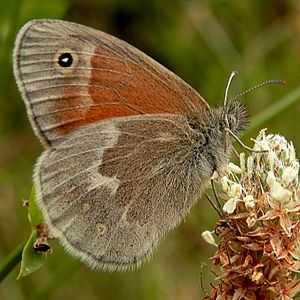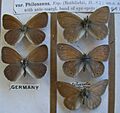Large heath facts for kids
Quick facts for kids Large heath |
|
|---|---|
 |
|
| Conservation status | |
| Scientific classification |
Coenonympha tullia, also known as the large heath or common ringlet, is a type of butterfly. It belongs to the Nymphalidae family, which includes many well-known butterflies. This butterfly lives in many different grassy places. You can find it along roadsides, at the edges of forests, in open clearings, and even in wet bogs. It also lives in cold northern areas like the arctic and alpine tundra.
This butterfly is not a very strong flyer. However, it can sometimes be seen flying along ditches. It does this when it is looking for new places to live. The large heath butterfly is found all over the northern parts of the world. This includes northern Europe, Asia, and North America. Otto Friedrich Müller first described this species in 1764.
About the Large Heath Butterfly
The large heath butterfly is known by its scientific name, Coenonympha tullia. It is a fascinating insect that adapts to many environments. From sunny prairies to cold tundra, it finds a way to survive. Its wide range across the Northern Hemisphere makes it a truly holarctic species. This means it lives in northern regions around the globe.
Where Does the Large Heath Live?
This butterfly can be found in many different habitats. It likes places with lots of grass. These include open fields, the edges of woodlands, and clearings within forests. You might also spot it in wet areas like bogs. In colder regions, it lives in arctic and alpine taiga and tundra. These are cold, treeless plains.
The large heath is not a very strong flyer. It tends to fly close to the ground. Sometimes, it will fly along ditches. This helps it find new grassy areas to settle in. Its ability to live in so many different places shows how adaptable it is.
Images for kids





